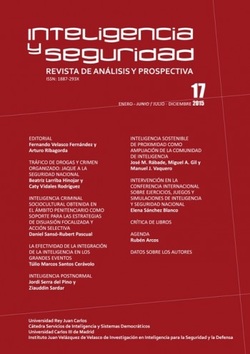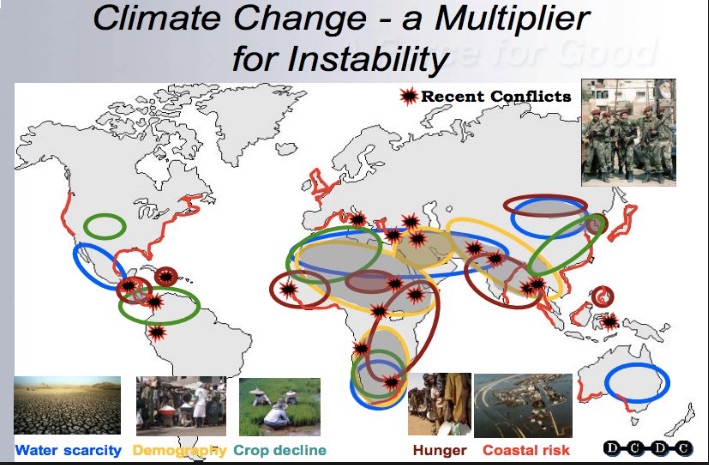 LA REVISTA INTELIGENCIA Y SEGURIDAD: REVISTA DE ANÁLISIS Y PROSPECTIVA. acaba de publicar en su Nº 17, nuestro artículo: "Inteligencia sostenible de proximidad como ampliación de la comunidad de inteligencia" : Rábade Roca, José Manuel; Miguel A. GIL; Manuel J. VAQUERO. del que ofrecemos un pequeño resumen. "En un contexto de cada vez más incertidumbre securitaria glocal (global y local) emergen las ciudades, junto a otros entes territoriales y grupos de convivencia social más o menos formales, como complementos necesarios para una comunidad de inteligencia abierta y ampliada. En este nuevo contexto, esta diversidad de entes serían el eje principal, de una inteligencia sostenible de proximidad, que fortalecería la comunidad de inteligencia frente a los nuevos retos a los que se enfrenta la Seguridad Nacional. Además, estas entidades basados en la vecindad territorial, y en particular las ciudades, estarían en condición de fortalecer un nuevo paradigma de seguridad e inteligencia local, basado en la proximidad, la gobernanza y la prospectiva, ayudando a la eficiencia, resiliencia y la sostenibilidad del sistema de Seguridad Nacional de España. Palabras clave: Comunidad de Inteligencia ampliada, Inteligencia Sostenible de Proximidad, cultura de inteligencia, resiliencia, Estrategia de Seguridad Nacional" Abstract: In the context of increasing uncertainty in "glocal" (global and local) security, cities and other territorial entities, along with other forms of more or less formal social coexistence, emerge as supplements to a more open and greater intelligent community. In this new context, this diversity of entities would be the primary axis of a sustainable intelligence of proximity. This would strengthen the intelligence community dealing with the new challenges faced by the National Security. Also, this diversity of territorial entities, particularly in cities, would be in a position of being able to strengthen a new paradigm of local security and intelligence, based on proximity, governance, and prospective outlook. This, in turn, would support the efficiency, resilience and sustainability of the National Security system of Spain. Keywords: Aumented intelligence community, Sustainable Inteligence of Proximity, intelligence culture, resiliencia, National Strategy Security OTROS INTERESANTES CONTENIDOS DE ESTE EJEMPLAR SON: - Tráfico de Drogas y Crimen Organizado: Jaque a la Seguridad Nacional. Beatriz LARRIGA HINOJAR . C. VIDALES RODRIGUEZ - Inteligencia Criminal Sociocultural obtenida en el ámbito penitenciario como soporte para las estrategias de disuasión focalizada y acción selectiva. Daniel SANSO RUBERT PASCUAL. - La Efectividad de la Integración de la Inteligencia en los grandes eventos. T. Marcos SANTOS CERAVOLO - Inteligencia Postnormal. Jordi SERRA del PINO, Z. SARDAR - Intervención en la Conferencia Internacional sobre Ejercicios, Juegos y Simulaciones de Inteligencia y Seguridad Nacional . Elena SANCHEZ BLANCO En el mismo número: CRITICA de LIBROS AGENDA Datos sobre los autores.
0 Comentarios
 PROF HALVARD BUHAUG. REPRODUCIMOS ESTE INTERESANTE ARTÍCULO DEL PROFESOR HALVARD BUHAUG, -Research Director and Research Professor at the Peace Research Institute, Oslo (PRIO)-. PUBLICADO EN LA REVISTA CARBON BRIEF. Does climate change constitute a threat to peace and security? Many agree that it does. The US administration’s new National Security Strategy, launched last month, portrays climate change as ‘an urgent and growing threat.’ And this week, a new study appears to add scientific credibility to this concern, suggesting human-caused climate change contributed to the drought that preceded the Syrian civil war. So does the Syrian case represent a general pattern, where climate changes and extremes are systematically increasing conflict risk? The short answer is no. But if scientists want to explore these links more closely, there are a few steps they need to take. Cacophony of different findings Recent research has reported a strong effect of climate extremes on violent conflict, yet many researchers question the robustness of such a link. Some even argue the relationship between climate and conflict is so complex that it can never fully be captured and understood. There are legitimate reasons to be concerned about the impacts of climate change on security. However, a decade of research into the area appears to have produced more confusion than knowledge. But the cacophony of different findings and inadequate scientific evidence could be the result of poor data and simplistic research designs, rather than because no relationship exists. In trying to establish links that can be observed and quantified, I see five key challenges that need to be addressed. Poor data and vague hypotheses The first challenge is to move away from grouping all impacts of climate change under the same banner. We should specify which climate condition or event we consider a security threat, and what the implications could be. There is no reason why we should expect a flood to have the same impact on social behavior as the early arrival of the rainy season or a particularly wet year. Yet poor data and vague hypotheses seem to suggest that these distinct phenomena often look similar, and are treated as such. Second, researchers should avoid the naive assumption of a simple and direct cause-and-effect link between climate and conflict. We should specify how a climatic condition could cause social unrest directly, or how they could contribute to existing problems. In general, there is a tendency to underestimate or outright ignore the importance of the role of government or other institutions. For example, could local food price shocks constitute an intermediate step between drought and conflict? Possibly, but a failed harvest might not lead to food shortages or price rises if the situation is managed by a competent government. Proponents of violence Conflicts do not materialise out of thin air. So a third challenge is to consider who are the proponents of violence and what they are fighting for. A conflict might not necessarily be provoked by the people most frustrated by a situation. Affected people at the margins may simply be too weak to protest, or they may lack the organisational skills needed to mobilise and act as a collective. A government can exploit a difficult environmental situation to excuse their own poor management – an accusation levelled at the Syrian government. Fourth, researchers should consider not just who might be affected, but how they are likely to react. Urban residents are unlikely to employ guerrilla warfare in response to rising cost of bread, for example, but may well turn to the streets in large numbers to protest. While organising a rebel movement needs planning, resources, know-how and motivated recruits. And a full-blown civil conflict requires a state government that is willing to respond with military force. Until recently, researchers were limited to studying civil wars, which are perhaps the least climate-sensitive type of conflict one can imagine. But recent advances in data collection now make it possible to investigate a much broader range of conflict types. Time and distance The final challenge is how to consider the time and distance between the climate-related disaster and a conflict. Flooding will have a much more instant impact on a society than drought or rising sea levels, for example, and a dwindling water supply might be made worse by a neighbouring country upstream. The Syrian uprising, for example, was preceded by a multi-year drought, which itself was preceded by another severe drought. At the same time there was an influx of refugees fleeing Iraq. Where do researchers draw the line for contributing factors? Unfortunately, researchers are often restricted into using data averaged over a whole county and across whole years, which isn’t sufficiently specific. Certainty and uncertainty Let’s be honest; research on social processes always comes with a considerable margin of uncertainty, and even if the five challenges discussed above are addressed, there will be limits to what we can say about climate and conflict. For example, we will never be able to conclude with certainty that a given conflict would never have occurred in the absence of climate change, or that a conflict would certainly have occurred if a society hadn’t adapted to that change. Likewise, despite advances in conflict forecasting methodologies, we will never be able to predict the onset of a new violent conflict with certainty based on data alone. But it should be remembered that the climate-conflict link can work the other way as well. The destructive nature of armed conflict means it will increase a society’s vulnerability to the impacts of climate change. Civil war is development in reverse. Therefore, in unstable corners of the world, ending violent conflict may be the most efficient and cost-effective way to improve resilience to climate change. ENLACE: CARBON BRIEF. CLEAR ON CLIMATE Foto Inferior: CLIMATE CHANGE: DROUGHT= ARMED CONFLICT + POLITICAL INSTABILITY= MASS MIGRATION, AS IN SYRIA |
José Manuel Rábade RocaPh.D. Ciudadano crítico. Trabajando e investigando en seguridad, pero ante todo abierto al cambio. Archivos
Noviembre 2023
|

 Canal RSS
Canal RSS
